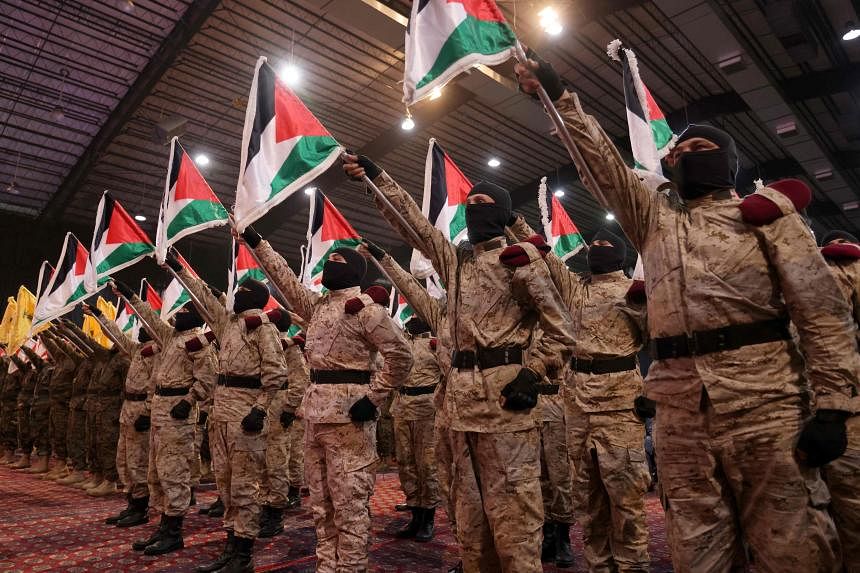As Israel braces for retaliation for an April 1 air strike on Iran’s diplomatic buildings in the Syrian capital Damascus, intelligence officials posed two possibilities: Iran might attack Israel directly or it could lash out through the network of allied foreign militias it has supported and nurtured for decades.
On April 13, Iran opted for the former – for now – and launched unmanned aeriel vehicles, or drones, and missiles toward Israel.
The militias, which have stepped up actions against Israel since the start of its war with the Iran-backed Palestinian group Hamas in October, may yet escalate their aggression should Israel-Iran tensions provoke a broader regional conflagration.
Iran has been funding and arming militant groups abroad since soon after the 1979 Islamic Revolution, as the nation’s new fundamentalist Shi’ite Muslim leaders sought to spread their mission to the rest of the region. They are nurtured by Iran’s Quds Force, a wing of the country’s elite Islamic Revolutionary Guard Corps that emerged from Iran’s 1980 to 1988 war with Iraq. Though Iran fought Iraq’s better armed, Western-backed forces to a standstill, the economic and human cost was devastating. Iran’s leaders have avoided open warfare since, preferring the deniability and lower casualty rates offered by the use of covert operations and proxy forces.
Hezbollah
The initial focus of Iran’s militia strategy was in Lebanon, where it backed the Shi’ite group Hezbollah. Hezbollah was formed in 1982 in reaction to Israel’s occupation of the country’s south, and was inspired by Iran’s revolution. Though Israel withdrew from Lebanon in 2000, Hezbollah has continued to attack it, saying Israel still occupies a patch of Lebanese territory. Israel and Hezbollah have fought repeated battles, including a war in 2006. After the Oct 7 Hamas attack that set off that group’s latest war with Israel, Hezbollah began launching missile, mortar and rocket strikes on northern Israel in solidarity with the Palestinian group.
Like Hamas, Hezbollah is designated by the United States as a terrorist organization. The group is thought to have been behind a number of major attacks on US targets in the 1980s. The authorities in Argentina blamed Hezbollah for two bombings in Buenos Aires, one at the Israeli embassy that killed 29 people in 1992, the other at a Jewish community centre that killed 85 people two years later. The US and Israel say Iran was behind the bombings.
Houthi rebels
The Quds Force was designed, Iran’s Supreme Leader Ali Khamenei said in 1990, to “establish popular Hezbollah cells all over the world”. The most recent expression of that policy is Iran’s elevation of Yemen’s Houthi rebels. The Houthis, followers of the Zaidi branch of Shi’ite Islam, have controlled north-western Yemen since civil war broke out in 2014. Iranian weapons, training and intelligence have enabled them to significantly improve their military abilities. In solidarity with Hamas, they have attempted to strike Israel with missiles and drones and have launched repeated attacks on ships plying the Red Sea, disrupting global trade.
Shi’ite militias in Iraq and Syria
Iran’s policy of backing militants in other countries expanded dramatically after the US-led invasion of Iraq in 2003, which brought about 150,000 American troops to Iran’s border, as well as a long-sought opportunity to dominate Iraq – once part of the Persian Empire based in what is modern-day Iran – through the country’s newly empowered Shi’ite majority. The Revolutionary Guards began organising and arming Shi’ite militias with roadside bombs and other equipment to attack US forces in Iraq, with the goal of driving them out.
Iran’s backing of Shi’ite militias in Iraq moved into the open in 2014, when the Iraqi government formally endorsed them as a means to fight the extremists of Islamic State, under the umbrella designation of Popular Mobilisation Forces. Their firepower and prominence gave Iran leverage to shape Iraqi governments.
In Syria, Iran intervened to preserve its only state ally, Syrian President Bashar Al-Assad, against what began in 2011 as a popular rebellion, mainly among his country’s majority Sunni population. Unwilling to commit large numbers of its own troops, Iran enlisted Hezbollah and militias from Iraq, as well as Shi’ites from Afghanistan and Pakistan, to fight in Syria. Though it took Russia’s help, the policy succeeded in saving Assad and securing a land route for Iranian military supplies, from Tehran to Lebanon.
After the Israel-Hamas war began, an umbrella organisation of Iran-backed Shi’ite militias in Iraq and Syria calling itself the Islamic Resistance began taking credit for attacks on US forces in those two countries and in Jordan. The attacks dropped off after the US launched major retaliatory strikes in February, including against targets linked to the Revolutionary Guards.
After Oct 7, Israel stepped up strikes against Iran-backed militias in Syria after they moved close to the Israeli border. The April 1 attack in Damascus was just the latest deadly strike in recent months on the Revolutionary Guards in Syria that Iran blamed on Israel.
Varying degrees of control
The degree of control Iran exercises over militias it supports varies. On one end is Iraq’s Kataib Hezbollah, a constituent of the Islamic Resistance, which is thought to function like an entity under Iran’s direct command. In the middle is an ideological ally such as Hezbollah, which would pursue common goals even if Iran lost interest. At the other end is Hamas, which, unlike the other groups, is made up of Sunni rather than Shi’ite Muslims. Hamas is a partner of expediency that will align with Iran only so long as it serves its financial and political interests. BLOOMBERG

